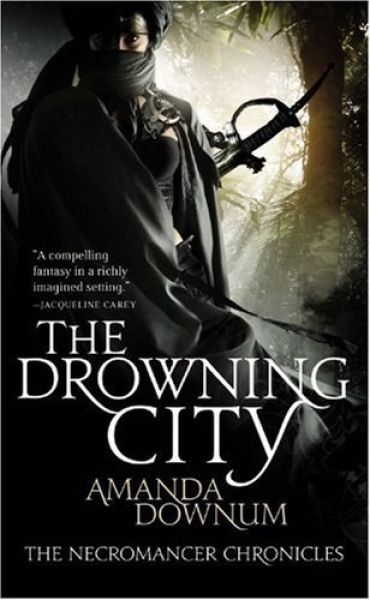A Spy Abroad
The Drowning City (The Necromancer Chronicles, volume 1)
By Amanda Downum

18 Aug, 2015
0 comments
Amanda Downum’s 2009 debut novel The Drowning City, first of the Necromancer Chronicles, takes us to the exotic city of Symir, a city balanced between ocean, river, and volcano. As the city’s sobriquet “The Drowning City” suggests, water has a slight edge over fire at present. To necromancer Isyllt Iskaldur, who has spent three weeks sailing from her homeland of Selafai, the Drowning City is exciting and novel. Most importantly it’s a potentially useful catspaw in the ongoing struggle between Selafai and the Assari Empire.
For the people who live in Symir, the city isn’t exotic at all. It’s home. And as convenient as it would be for Isyllt and her spymaster boss if the Symirians were willing to become naive pawns in the Selafian plots, the Symirians have their own complex relationships with the Empire of which they are a reluctant part. They have no intention of playing along with Isyllt’s cunning plans.
In fact, the locals have their own cunning plans and Isyllt will be doing quite well to survive contact with them.
Selafai’s brilliant scheme is to stir up a rebellion in Symir that will distract the Empire from their designs on Selafai. While the rather hazy intelligence Selafai has about Symir is correct as far as it goes, it doesn’t go far enough. For that matter, Selafain spycraft seems incomplete in a number of ways — perhaps the most important of which is that Isyllt seems almost as adept at concealing her role as a spy as was James Bond.
It’s not just that the Symirians are politically sophisticated, or that they’re not that into the idea of dying for Selafain freedom. There are at least five factions working against each other in Symir: the Empire, upper class Symirians who made an uncomfortable deal with the Empire in exchange for limited local autonomy, merchants chafing at high taxes (but who don’t have any particular sympathy for the lower classes), and the two factions opposed to the Empire, the moderate Jade Tigers and the violently extremist Dai Tranh. Each faction has its own schemes. Because interfaction relations range from grudging cooperation to violent loathing (and frequently shift!), the groups spend most of the book working at cross-purposes.
Five factions? There are also the angry ghosts of the dead, the bound spirit of the river, and most intriguingly, the volcano itself, straining against the magical chains that prevent it from fully expressing itself.
Magical chains that at least one person knows how to break.…
~oOo~
A quick question: is it just me or do authors trying to describe POC tend to rely overmuch on food-based similes? Although I guess there are phrases like “apple-cheeked” for white people.…
Authors want to imagine worlds to which their readers can easily relate. Even if their settings include actual verifiable ghosts or jinn with whom one can enjoy a nice cup of tea, it’s as if there were a strange attractor dragging imagined societies away from the completely alien and back towards familiar models. The exact model will vary from author to author; on this case the Empire seems to me to be modeled on Middle Eastern and Asian empires like the Ottoman and Mughal Empires [1]. Symir seems to be drawing on Indochina.
While I am not sure if there’s a specific historical model for Selafai, their bold scheme to interfere in the internal politics of a little-known far-off land has so many precedents I don’t know where to begin. The vast gap between the spycraft competence with which the Selafain credit themselves and the incompetence they actually demonstrate also seems terribly familiar.
Downum does a fairly good job of supplying the various factions with characters who may not be entirely likable, but at least have motivations that seem believable, The decision to attempt a volcanic eruption might be seen as verging on the extreme in some circles, but the people who make that attempt have reasons to think that’s a reasonable course of action (reasons beyond “blowing shit up and killing people is fun”).
What I liked most about this when I read it back in 2009 was how quickly Isyllt’s plan goes off the rails, which is pretty much at the moment her boot touches the dock at Symir. That might seem a little mean of me but Isyllt is trying to shore up the defenses of Selafai with the bodies of the Symrians.
The Drowning City is available from Orbit.
1: The Mughal Empire, even at its greatest and very impressive extent, never reached Indochina but it certainly got closer than the Ottomans. The geographic details we get about the Empire seem more like India and Central Asia than the Ottoman Empire.
